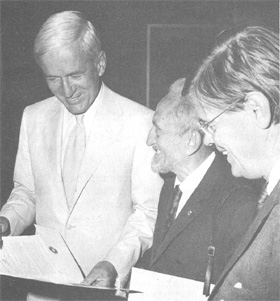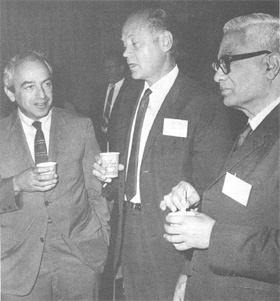Dr. Seaborg Praises NAL Planning and Progress


Prominent men and women in science and world affairs from 35 countries are meeting in the relatively relaxed surroundings of The Abbey, a resort hotel in nearby Lake Geneva, Wisconsin, to exchange opinions on major problems confronting mankind.
Some 110 scholars and scientists are attending the 20th Pugwash Conference on Science and World Affairs. The conference gets its name from the site of the first conference held in 1957 in Pugwash, Nova Scotia, the birthplace of its benefactor, Cyrus Eaton, the Cleveland, Ohio, industrialist.
This year, the theme of the two-week seminar is: "Peace and International Co-operation: A Program for the Seventies." The meetings are sponsored by the Adlai E. Stevenson Institute of International Affairs at the University of Chicago, directed by William R. Polk, a professor of Middle Eastern history. Dr. Robert R. Wilson, NAL Director, and Mrs. Wilson, who is book editor of The Bulletin of the Atomic Scientists, attended the first working meetings last week at Lake Geneva.
Last Saturday, some of the Pugwash scientists and scholars took a busman's holiday and visited NAL while others toured the Art Institute of Chicago and still others attended an "Operation Breadbasket" meeting on Chicago's South Side led by the Reverend Jesse Jackson.
About 20 scientists and scholars from the Pugwash meeting were welcomed to NAL at an informal meeting in the Village Barn conducted by Dr. Wilson. The NAL Director then introduced Dr. Glenn T. Seaborg, the Nobel laureate in chemistry who is chairman of the U.S. Atomic Energy Commission.
The AEC chairman said that he was fortunate to be in Chicago at a time when the Pugwash group was to be at NAL. He had come here to do some work at Argonne National Laboratory and to deliver a speech at the American Chemical Society annual convention in Chicago. Then, he turned to the theme of international co-operation, saying:
"This Laboratory will be open, under the proper auspices, to scientists from all over the world."
Dr. Seaborg said that he had been in communication with senior members of the Russian scientific leadership to develop plans for international co-operation in the area of high energy physics research at NAL when it is completed.
Dr. Seaborg said that the development and construction of NAL has been a "real success story so far." He said that the NAL effort was "about the only case where a large project was coming in ahead of schedule, delivering more energy than it was designed for and at a cost less than projected." He singled out Dr. Wilson with praise for his "leadership" in "this success story."
Looking into the long-range future of elementary particle physics developments, Dr. Seaborg told the Pugwash group: "If we ever build another accelerator bigger than this one, it could possibly be an international machine. It appears that it will be harder and harder to get funds for such large machines on a purely national basis." The proton synchrotron being developed at NAL has been authorized by Congress for $250,000,000.
In his brief speech, Dr. Wilson advised the group that the NAL machine originally was designed for 200 BeV. However, he said, it now appears that it will provide protons with energies up to 500 BeV. He also outlined the general site layout and described the current status of construction. The meeting was followed by a tour of the main site and a luncheon. Representatives of the United Kingdom, France, Japan, Rumania, Poland, the U.S.S.R., India, the United Arab Republic, and Senegal were in the group.




